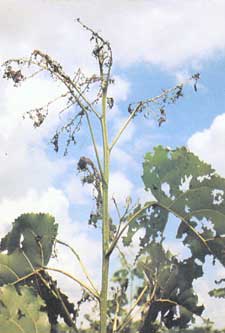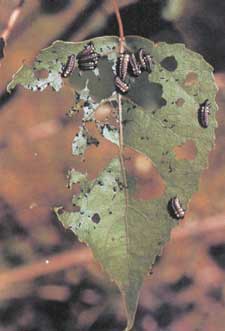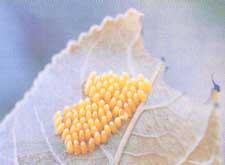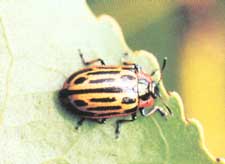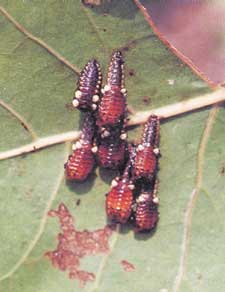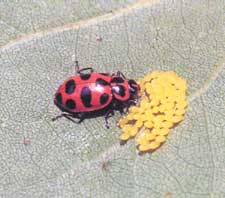Cottonwood Leaf BeetleForrest L. Oliveria - Supervisory Entomologist, Region 8, USDA Forest Service, Pineville, LA, and Cordell C.E., Anderson R.L., Hoffard W.H., Landis T.D., Smith R.S. Jr., Toko H.V., 1989. Forest Nursery Pests. USDA Forest Service, Agriculture Handbook No. 680, 184 pp. Hosts Eastern cottonwood is the major host, particularly in the South, for the cottonwood leaf beetle (Chrysomela scripta). Poplars, willows, and alders are also affected. Distribution The cottonwood leaf beetle occurs throughout the United States but is most numerous in the lower Mississippi River Valley. Damage These beetles are serious defoliators of cottonwoods, particularly in the South and West. Continuing defoliation and twig damage through the summer reduces seedling growth and vigor. Lateral buds sprout below the injured terminals and grow rapidly, resulting in multiple-forked tops. Stunted growth in nursery plantings reduces cutting yield. Diagnosis Look for the sudden appearance of ragged foliage near branch ends and terminals (fig. 38-1). Some leaves will have brown patches where young larvae have skeletonized the leaves. Other leaves will have only their veins and midribs remaining. Heavy damage results in dead, black terminals with most of the leaf tissue consumed. Also look for black droppings on leaves. Egg clusters, gregariously feeding larvae, and adult beetles are present on the affected foliage. The lemon-yellow eggs (fig. 38-2) are laid in clusters of 15 to 75 eggs on the underside of the leaves. Larvae are blackish to gray and about 12 mm long when mature (fig. 38-3). There are two whitish spots on the sides of each segment. When disturbed, they release a pungent odor. Adults have a wide variety of color markings. Beetles are oval, yellow, and about 6 mm long, with slender black markings on their wingcovers (fig. 38-4). The head and thorax are black, and the margins of the thorax are yellow or red.
Control Prevention - Use cottonwood clones that have demonstrated tolerance to leaf beetle defoliation. Cultural - Employ sanitation practices in and around nurseries to either destroy the hibernating beetles directly or to expose them to winter temperatures. Chemical - Apply chlorpyrifos for the control of cottonwood leaf beetIe adults and larvae. Schedule the insecticide applications before larvae enter the pupal stage; treating at this time minimizes damage to predator populations. Selected References Morris. R.C.: Filer. T.H.. Jr.: Solomon. J.D. [and others]. 1975. Insects and diseases of cottonwood Gen. Tech. Rep. SO -8. New Orleans, LA: U.S. Department of Agriculture. Forest Service, Southern Forest Experiment Station. 37 p. Neel, W.W. Morris. R.C.; Head. RB. 1976. Biology and natural control of the cottonwood leaf beetle, Chrysomela scripta (Fab.) (Coleopatera: Chrysomelidae). In: Thielges, B.A.; Land. S.B., Jr., eds. Symposium on eastern cottonwood and related species. Proceedings: 1976 September 28- October 2; Greenville, MS. Baton Rouge. LA: Louisiana State University: 264-271. U.S. Department of Agriculture. Forest Service. 1985. Insects of eastern forests. Misc. PubI. 1426. Washington, DC: U.S. Department of Agriculture . 608 p. |
Forest Pests: Insects, Diseases & Other Damage Agents |

|
|
